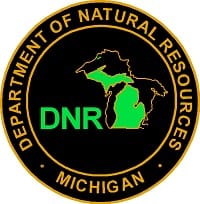Lake Sturgeon Stocked in Northern Michigan Inland Waters This Week

The Department of Natural Resources announced that approximately 18,500 young lake sturgeon from a streamside sturgeon-rearing facility were stocked in several inland lakes in northern Michigan on Monday, July 1.
The rearing facility, located on the banks of the Black River in Cheboygan County, is operated to facilitate lake sturgeon rehabilitation in the Cheboygan River watershed. This facility is operated through cooperative efforts involving the DNR, the Black Lake Chapter of Sturgeon for Tomorrow, Michigan State University (MSU) and Tower-Kleber Limited Partnership.
Along with raising fish for sturgeon recovery, the rearing facility conducts research on lake sturgeon thanks to state, federal, Great Lakes Fishery Trust and Sturgeon for Tomorrow funds. Results provide much-needed guidance for managers involved in lake sturgeon recovery efforts, while improving the effectiveness of lake sturgeon culture and stocking efforts.
Each spring, MSU and DNR staff members collect and fertilize gametes (eggs and milt) from adult sturgeon returning to the Black River and rear the young at the streamside facility for approximately four months before releasing them as fall fingerlings in select waters. Black, Burt and Mullett lakes in Cheboygan County are priority stocking locations for those fall fingerlings.
“Survival of the eggs and fry exceeded expectations this year,” said Dave Borgeson, Northern Lake Huron Management Unit Supervisor for the DNR’s Fisheries Division. “Because the Black River location is a small streamside facility, it is not able to accommodate the large number of fry we had on hand. We stocked these young fish in appropriate locations that help us achieve our management goals of rehabilitating lake sturgeon populations in these waters.”
Selected and prioritized locations that were stocked with the small fingerlings on Monday were: Sturgeon River (a Burt Lake tributary), Pigeon River (a Mullett Lake tributary), Maple River (a Burt Lake tributary) and Otsego Lake. In addition, the DNR will transfer 3,750 of the young sturgeon to another fish production facility near Pellston, which is owned and operated by the Little Traverse Bay Band of Odawa Indians, later this week. Fish will be reared there and stocked later this fall.
“It is important to reduce the densities of fish at the facility so we meet our target of healthy fall fingers later this summer,” said Dr. Kim Scribner, an MSU professor and lead researcher at the streamside facility. “Holding too many fish at this point in the rearing process compromises the health of the young lake sturgeon and, ultimately, our chances of successful fall fingerling production.”
“These circumstances [availability of fry] afforded us another opportunity for supplemental stocking of sturgeon as we work toward lake sturgeon recovery throughout the Cheboygan River watershed,” said Brenda Archambo, president of the Black Lake Chapter of Sturgeon for Tomorrow. “We look forward to working with our partners, and we greatly appreciate and acknowledge the hard work of MSU and the DNR in their tremendous accomplishments in rearing lake sturgeon. Together, we are working to ensure our conservation legacy for future generations.”
For more information on lake sturgeon in Michigan, please visit www.michigan.gov/sturgeon.

